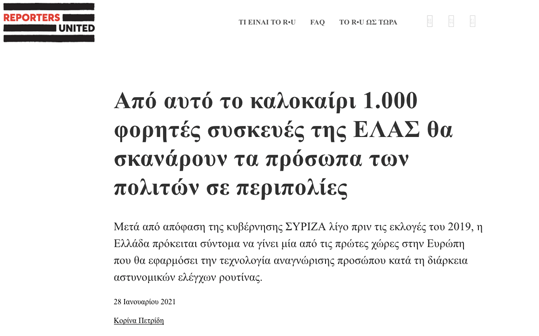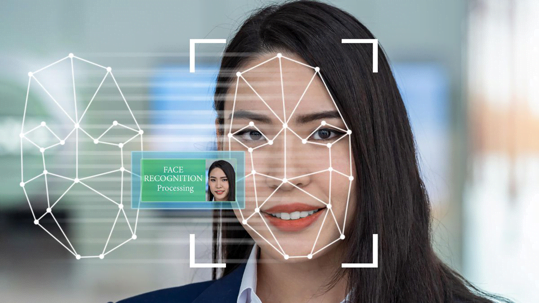
The report is titled From this summer 1,000 portable devices of ELAS will scan citizens’ faces during patrols; signed by Korina Petridi; date January 28, 2021; from the site “reporters united”. We transfer most of it, in order to subsequently add two or three comments.
… According to a Hellenic Police official who spoke to Reporters United, by the summer of 2021 it is estimated that the Greek police will have received “thousands of portable devices” that will resemble smartphones and will allow the identification of citizens using facial recognition software and fingerprint scanning.
“The purpose is the verification of persons, vehicles and objects in real time. This way, police safety will be improved, the unnecessary harassment of citizens will be reduced, and we will save human and material resources as well as working time,” an EL.AS. official said.
The project was awarded after an international competition to Intracom Telecom in March 2019. Intracom Telecom has for decades been the telecommunications arm of the Intracom group, interests of Sokratis Kokkalis. In 2006 a significant portion of it was sold to the Russian interests of Sistema. In 2014 the two main shareholders Intracom and Sistema sold all their shares to unnamed “investors from Dubai”. Today the company is controlled 100% by Intracom Middle East FZ-LLC.
It is worth noting that the tendering process, from the initial conception of the idea (2017) until the signing of the final contract in 2019, was implemented entirely by the SYRIZA government.
However, we were not informed about the existence of the project by either the government or ELAS. On July 2, 2019, that is, five days before the 2019 elections, the company Intracom Telecom with a press release “announced the signing of an agreement with the Hellenic Police Headquarters of the Ministry of Citizen Protection” for the “Smart Policing” project. It would take until the end of 2019 for ELAS to proceed with the “Contract Award Announcement” for the project.
The total cost of the program exceeds 4 million euros. 75% of the project’s cost was covered by the European Internal Security Fund, demonstrating a clear shift in the European Union’s approach to using artificial intelligence for crime prevention.

Face recognition technology/algorithms, although they have been used for years by various states (e.g. that of His Majesty…), gained great momentum – and “legitimization”… – in 2020… With the well-known argument: for the sake of public health! From China to Russia and from apartheid Israel to…. (up to where?) the digital profiling of as many citizens’ “biometric data” as possible was promoted as part of… prevention against the flying killer/plague… Yet another technological application that was ready for years but had been blocked due to lack of appropriate legitimization.
We had wondered (silently): since the racist, militarist ally of Hellasstan is a pioneer in this field, is it possible for the Greek security complex to fall behind? We got the answer: it was long before the coup that the fairoz (the party of Kουmουndούrοs is known as a “champion of individual and political rights”, right?) took care to pave the way for “facial recognition” surveillance and repression. And because, of course, they knew exactly what they were doing, they kept their work secret, and never mentioned it nor do they mention it in their triumphant achievements of their “first/second time”… Guilt-ridden silence…
But what does “facial recognition algorithms” mean? Imagine an electronic program that, through a camera, “reads” any face, analyzes it into a few dozen “points” (and the distances between them) and compares it with stored tens of thousands of faces (analyzed in the same way) in order to conclude the “identity” of the face. We could say: a certain geometry of each face is constructed, and it is compared within an organized pile/file of similar geometries. Ideally, for this trick to work, on the one hand all citizens’ faces should be recorded (and if possible from at least two different angles, front and profile…) and on the other hand the algorithm should be tested, retested and improved (from the number of facial points to the correlations between them) in order to avoid many errors… (Corresponding principles apply for “iris recognition” and others that whoever is interested will read about in the upcoming cyborg 20…)
For the guards to go out onto the streets with “thousands of smart devices” such as mobile phones and perform “facial recognition,” the existence of a large database of such data is presupposed; as large as possible a file of “faces,” in the possession of the authorities. Is there such a thing? Of course there is!!!
Police identity cards have also been digitized, but the photographs on them are not helpful, especially since in many cases they are very old. In contrast, photographs taken of those accused of serious crimes are useful; therefore, these should be the first priority. However, they are very few compared to the general population, and certainly not a large enough database for there to be hope of random “face recognition” on the street. Yet, without it, programmers cannot improve the performance (i.e., accuracy) of the algorithms.
So, something much broader is needed, beyond the authorities’ “criminal records.” Something that simultaneously includes (recent) photographs, constantly updated, along with the essential element: identity details or some of them that can be properly filled in. Is there such a thing available? Yes!!! We suspect (without being able to prove it…) that dedicated employees in digital public order services (or in the collaborating company…) using appropriate “tools,” have gathered all the photographic and video material of individuals available on the Greek accounts of the antisocial network “facebook,” together with the other identification details of each person!!! Indeed, this could have created a good and quite extensive database for facial recognition!
You will now say: yes, but what about generalized hygiene mask-wearing? Hmmmm… This could be an interesting challenge for the technologists of the relevant algorithms. If you look at the photo above, you will notice that indeed a mask hides almost half of the facial points…. However, if those that are visible are increased and, additionally, “assumptions” are made about the hidden ones, an acceptable (from the perspective of errors) conclusion may still emerge. No one is perfect, but “the enemy of good is better”…
After all, the technologies of the 4th industrial revolution are ALSO for the difficult…
Nice! Or not?
